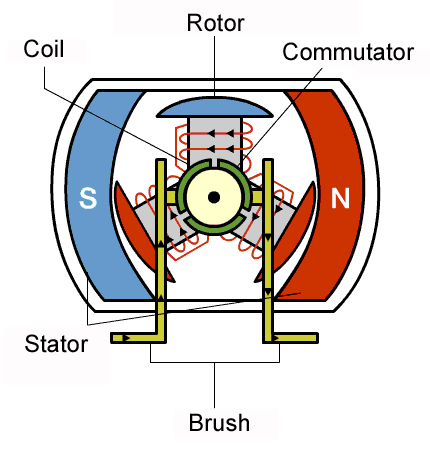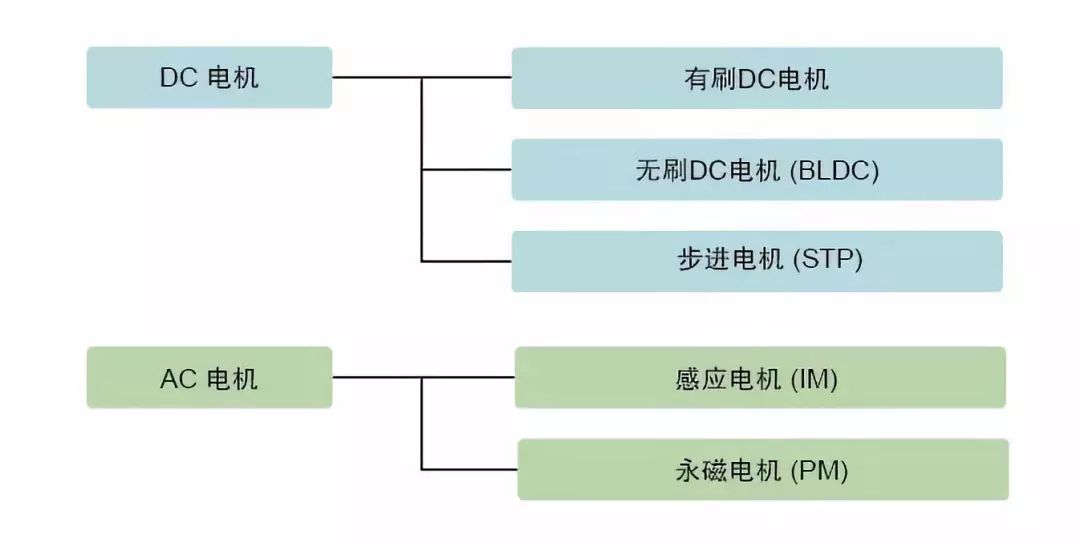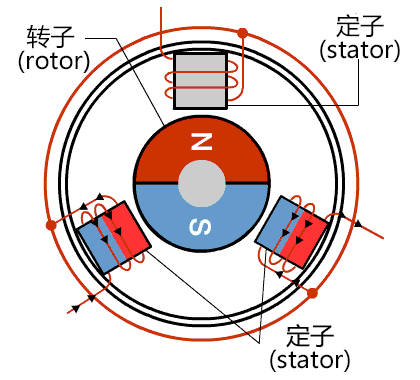What is a BLDC motor? After supplying electric power (voltage, current), it is the motor that can perform mechanical motion. There are a wide variety of motors, and the "BLDC Motor" has high efficiency and good operability, can be widely used in various applications, and is expected to bring about low power consumption. The motor is a kind of energy equipment When engineers want to use electrical and electronic machines to do something in the real world, they will think about how to turn electrical signals into "forces"? What converts an electrical signal into force is the actuator, the motor. The motor can be thought of as "a component that converts electrical into mechanical force." The most basic motor is “DC motor (brushed motor)â€. The coil is placed in the magnetic field, and by the current flowing, the coil is repelled by the magnetic pole on one side and is attracted by the magnetic pole on the other side, and is continuously rotated under this action. During the rotation, the current flowing into the coil is reversely flowed, causing it to continue to rotate. In the motor, there is a part called "commutator" which is powered by "brush". The position of "brush" is above the "steer" and it moves continuously with the rotation. The direction of the current can be changed by changing the position of the brush. The commutator and brush are indispensable for the rotation of the DC motor (Figure 1). Figure 1: Schematic diagram of the operation of a DC motor (brushed motor). The commutator switches the direction of current flow in the coil, inverting the direction of the magnetic pole so that it always rotates to the right. The brush supplies power to the commutator that rotates with the shaft. Motors active in multiple fields We classify the motor according to the type of power supply and the principle of rotation (Figure 2). Let's take a brief look at the characteristics and uses of various types of motors. Figure 2: Main types of motors A DC motor (brushed motor) that is simple in structure and easy to handle is generally used for applications such as "opening and closing of a disc tray" for home appliances. Or used in the car's "opening and closing of the electric mirror, direction control" and other purposes. Although it is cheap and can be used in many fields, it is also flawed. Since the commutator will come into contact with the brush, its life is very short and the brush or warranty must be replaced regularly. The stepper motor rotates with the number of electrical pulses that are sent to it. Its amount of motion depends on the number of electrical pulses sent to it, so it is suitable for position adjustment. In the home, it is usually used for "paper feeding of fax machines and printers". Since the paper feeding step of the facsimile machine depends on the specifications (grain, fineness), the stepping motor that rotates with the number of electric pulses is very convenient to use. It is easy to solve the problem that the signal will stop temporarily once the machine is stopped. A synchronous motor whose number of revolutions varies with the frequency of the power supply is used for purposes such as "a rotating table of a microwave oven". There is a gear reducer in the motor unit to get the number of rotations suitable for heating food. The induction motor is also affected by the frequency of the power supply, but the frequency and the number of revolutions do not match. Previously such AC motors were used on fans or washing machines. It can be seen that a wide variety of motors are active in many fields. Among them, what kind of characteristics does the BLDC motor (brushless motor) have so much use? How is the BLDC motor rotated? The "BL" in the BLDC motor means "brushless", that is, the "brush" in the DC motor (brushed motor) is gone. The role of the brush in a DC motor (brushed motor) is to energize the coils in the rotor through the commutator. So how does a BLDC motor without a brush energize the coils in the rotor? The original BLDC motor motor uses a permanent magnet as the rotor, and there is no coil in the rotor. Since there are no coils in the rotor, commutators and brushes for energization are not required. Instead, the coil is used as a stator (Fig. 3). Figure 3: Schematic diagram of the operation of a BLDC motor. The BLDC motor uses a permanent magnet as the rotor. Since there is no need to energize the rotor, brushes and commutators are not required. The power to the coil is controlled from the outside. The magnetic field produced by the fixed permanent magnet in the DC motor (brushed motor) does not move, and is rotated by controlling the magnetic field generated inside the coil (rotor). To change the number of rotations by changing the voltage. The rotor of a BLDC motor is a permanent magnet that rotates the rotor by changing the direction of the magnetic field generated by the surrounding coils. The rotation of the rotor is controlled by controlling the direction and magnitude of the current to the coil. Advantages of BLDC motors There are three coils on the stator of the BLDC motor, each coil has two wires, and there are six lead wires in the motor. In fact, because it is internal wiring, usually only three wires are needed, but one more than the previously mentioned DC motor (brushed motor). The positive and negative poles connected to the battery alone will not move. How to run the BLDC motor will be explained in the second round of this series. This time we are concerned about the advantages of BLDC motors. The first feature of the BLDC motor is "high efficiency." It is possible to control its swirling force (torque) to always maintain a maximum value. For DC motors (brushed motors), the maximum torque during rotation can only be maintained for one instant and cannot always be kept at a maximum. If the DC motor (brushed motor) wants to get the same torque as the BLDC motor, it can only increase its magnet. This is why small BLDC motors can also generate powerful power. The second feature is "good control", which is related to the first one. The BLDC motor can get the torque, the number of revolutions, etc. you want without any problems. The BLDC motor can accurately feedback the target number of rotations, torque, and so on. The heat generation and power consumption of the motor can be suppressed by precise control. If the battery is driven, the drive time can be extended by careful control. In addition, it is durable and has low electrical noise. The above two points are the advantages brought by the brushless. The DC motor (brushed motor) has a loss due to long-term use due to the contact between the brush and the commutator. The part that comes into contact also produces sparks. In particular, when the gap of the commutator hits the brush, there is a huge spark and noise. If you do not want to produce noise during use, consider using a BLDC motor. BLDC motors are suitable for these aspects Where are the BLDC motors with high efficiency, diverse handling and long life generally used? It is often used in products that can be used continuously because of its high efficiency and long life. For example: home appliances. People started using washing machines and air conditioners very early. Recently, BLDC motors have also been adopted in electric fans, and the power consumption has been greatly reduced. It is because of the high efficiency that the power consumption is reduced. A BLDC motor is also used in the vacuum cleaner. In some cases, a significant increase in the number of revolutions has been achieved by changing the control system. This example demonstrates the good control of BLDC motors. As a hard disk of an important storage medium, a BLDC motor is also used for the rotating portion thereof. Durability is important because it is a motor that requires long hours of operation. Of course, it also has a strong use to suppress power consumption. The high efficiency here is also related to the low consumption of electricity. There are many uses for BLDC motors. BLDC motors are expected to be used in a wider range of applications. BLDC motors will be widely used in small robots, especially in "service robots" that provide services in areas other than manufacturing. “Positioning is important for robots. Shouldn't you use a stepper motor that runs with the number of electrical pulses?†Someone might think so. But in terms of power control, BLDC motors are more suitable. In addition, if a stepping motor is used, a structure such as a robot wrist needs to be fixed at a certain position to provide a relatively large current. In the case of a BLDC motor, it is possible to supply only the required electric power in cooperation with an external force, thereby suppressing power consumption. It can also be used for transportation. In the past, most of the elderly electric vehicles or golf carts used simple DC motors, but recently they have begun to use high-efficiency BLDC motors with good controllability. The battery duration can be extended with subtle controls. BLDC motors are also suitable for use in drones. Especially for multi-axis rackless drones, since it controls the flight attitude by changing the number of revolutions of the propeller, it is advantageous to be able to precisely control the rotating BLDC motor. how about it? BLDC motors are high-quality motors with high efficiency, good controllability and long life. However, in order to maximize the power of the BLDC motor, correct control is required. How to operate? Let us look forward to the next time. SMA means surface mount assembly. It is a new generation of electronic assembly technology, which compresses traditional electronic components into a device with a volume of only a few tenths. Zener Diodes,Surface Mount Standard Rectifiers,Smd Bridge Rectifier,zener diodes manufacturers Changzhou Changyuan Electronic Co., Ltd. , https://www.cydiode.com


Surface mounting is not a new concept, it is derived from earlier processes, such as flat mounting and mixed mounting.
For the assembly of electronic circuits, a point-to-point wiring method was initially adopted, and there was no substrate at all. The packaging of the first semiconductor device uses radial pins, which are inserted into the through holes of the monolithic circuit boards that have been used for the packaging of resistors and capacitors. Active components have been widely used in the past ten years.